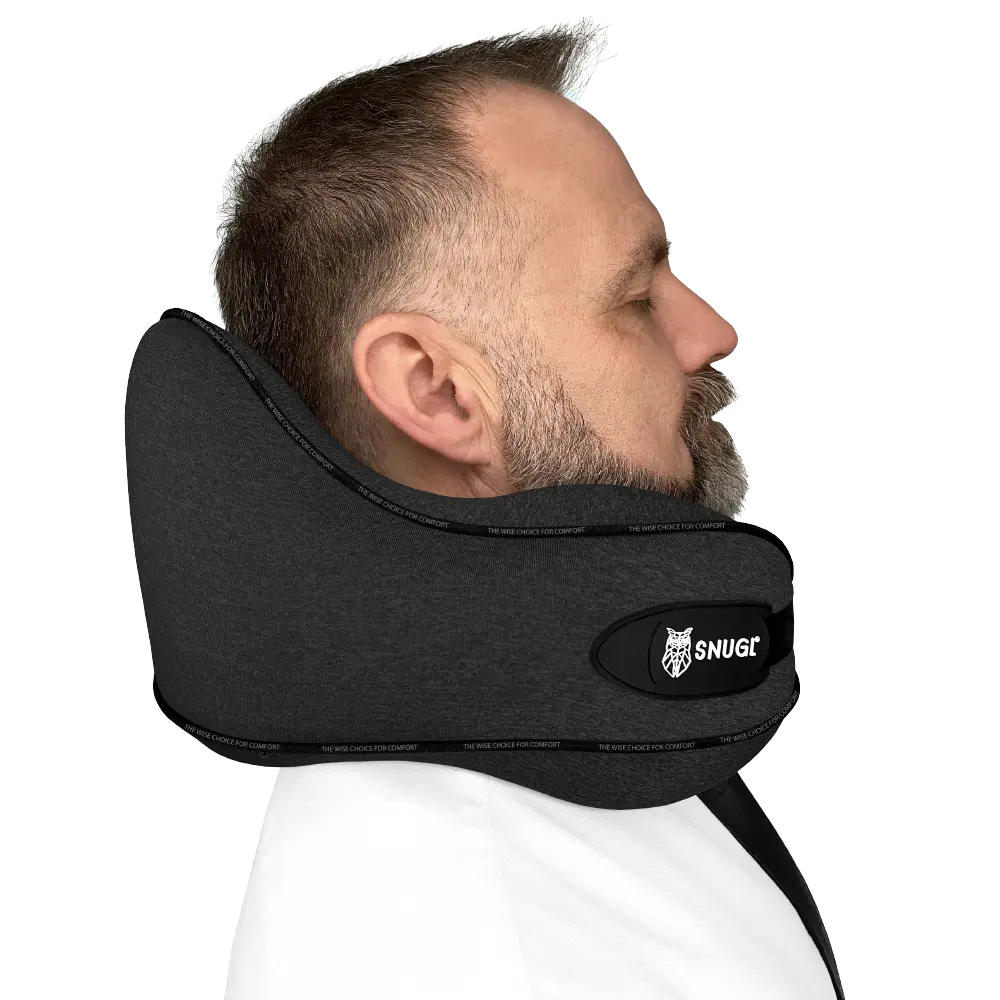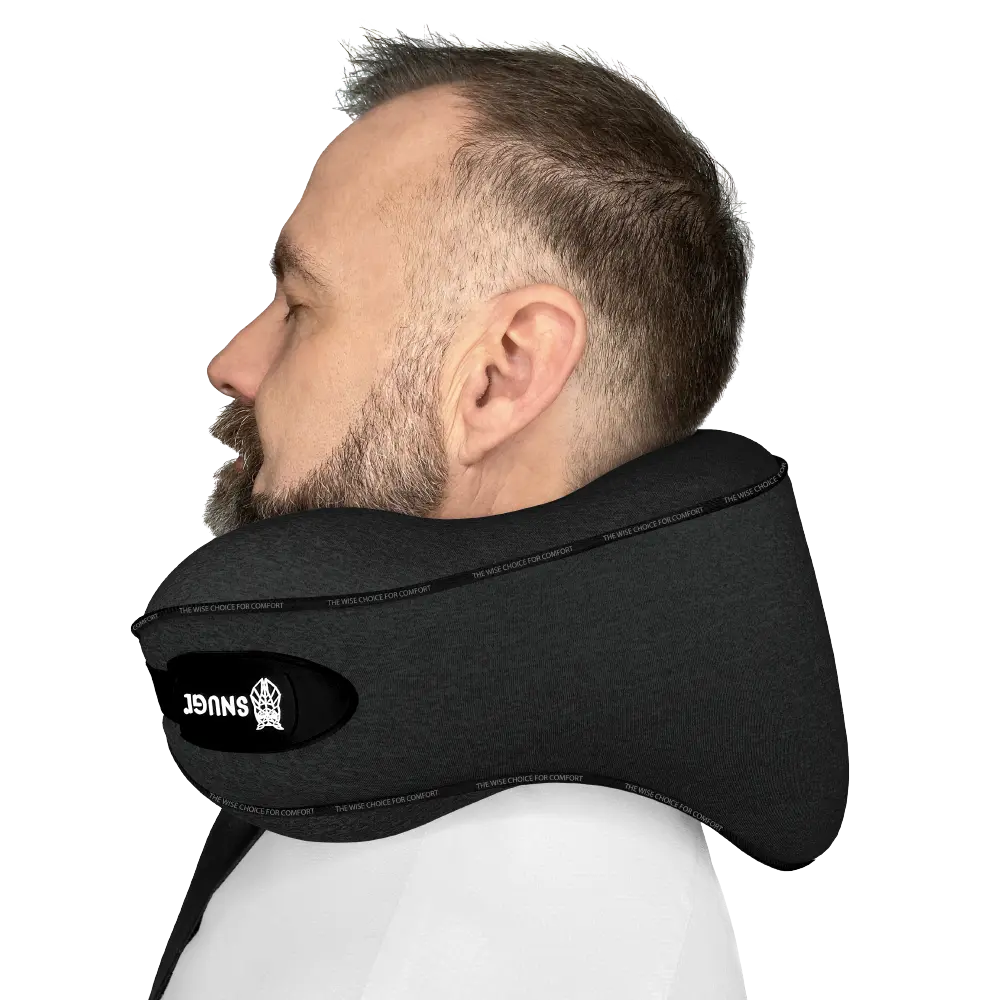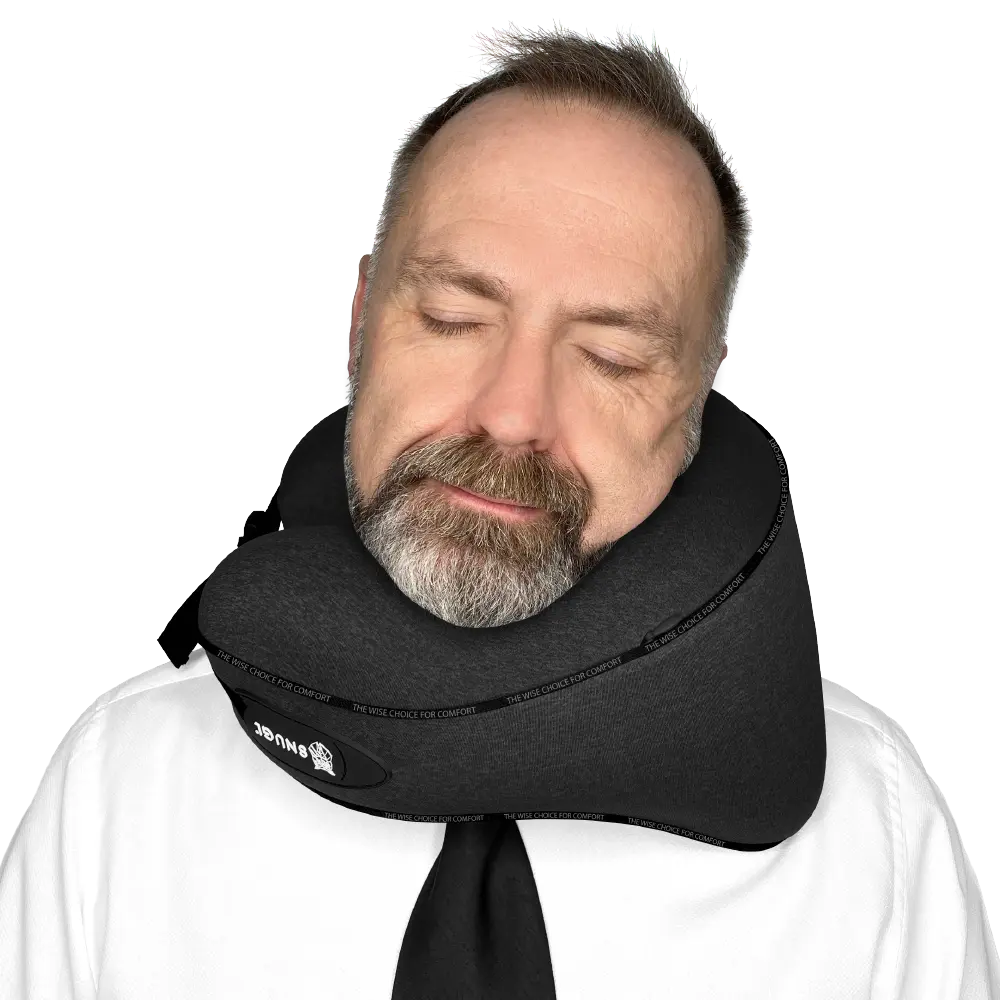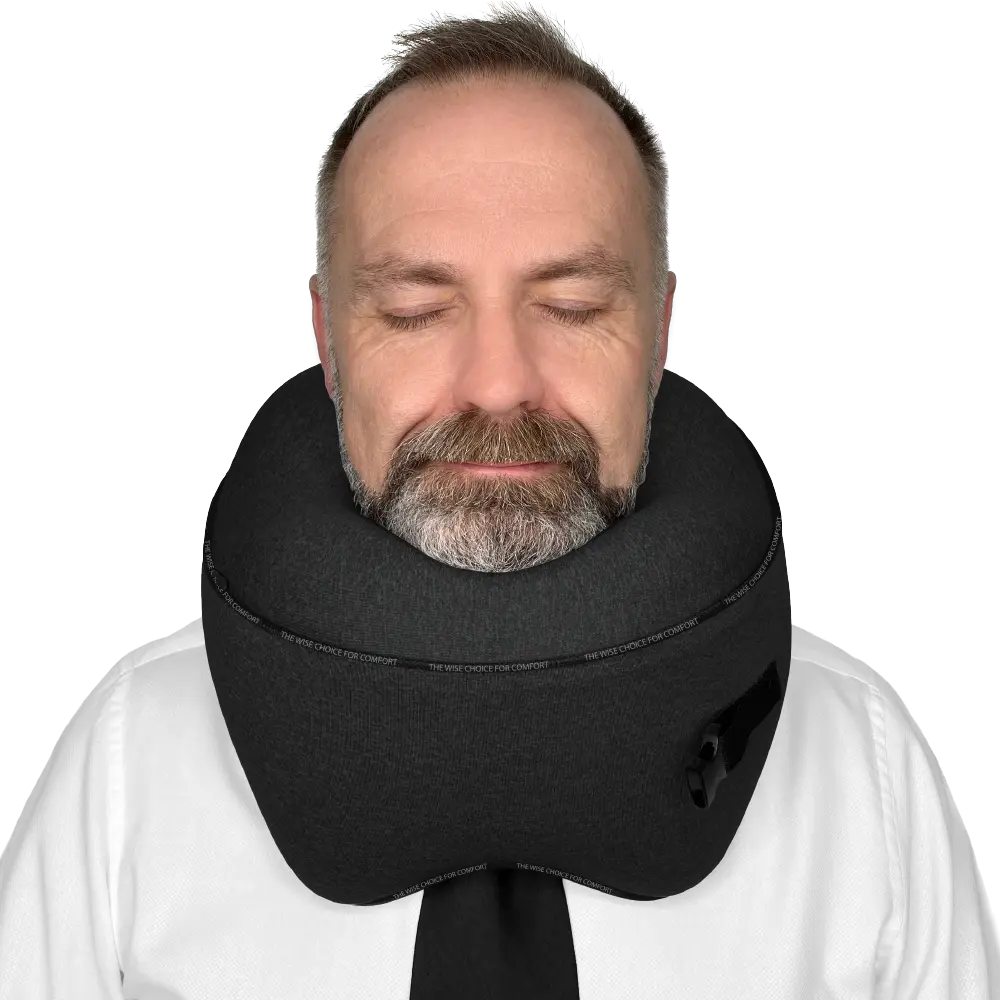Stop! You’re doing it all wrong.
Travel pillows are an essential packing item for long-haul flights and weary travellers.
Sadly, most people aren’t using them the right way to maximise comfort. But we’re on a mission to fix that and answer the question of how to wear a travel pillow.
Today, we’ve got insights from a fellow traveller plus a doctor’s recommendations on how to get the perfect rest using your travel pillow.
The Right Way to Wear a Travel Pillow
Using a travel pillow correctly is the first step to getting comfortable with it. Unfortunately, ever since these specially-designed pillows became a traveller’s favourite, we’ve all been using them wrong.
Apart from Snugl customers, of course. The insert card included in our box has been showing the right way to use them since we launched in the late 2010’s.
In 2021, TikToker @sidneyraz uploaded a clip showing the simple solution to making travel pillows more comfortable - turn the snap enclosure side to the back instead of the front.
Yup, that’s right. That bit goes at the back.
@sidneyraz you can actually sleep on a flight #traveltipsandtricks #inmy30s ♬ original sound - sidneyraz
The viral video now has over 36M views, most of which are travellers shocked to realise the truth of how to wear travel pillows.
Since the TikTok video, several other trends and news stories have appeared online showing the right way to use a travel pillow.
Better late than never for an invention created in the early 1920’s.
But you can also wear your travel pillow in other positions. While the front is often the most correct, there are some situations where "backwards" might even be best.
So, to save you hours of shifting in your seat or having your head nod, here are a few things to know.
The Conventional Position

The conventional position involves placing the neck pillow behind your neck, with the bulk of the pillow supporting the cervical spine (that's your neck).
This position allows for neutral neck alignment, which can benefit you if you've got a normal cervical spine alignment and no specific neck issues. Here are the benefits and drawbacks of the conventional position.
Benefits
- Provides support and helps maintain a neutral alignment of the cervical spine.
- Can help alleviate muscle tension and strain in the neck and upper back.
- Suitable for most people without any specific neck conditions.
Drawbacks
- May not provide adequate support if you have certain neck conditions, such as herniated discs or cervical radiculopathy.
- May not be the most effective position if you experience snoring or sleep apnea.
Reversed Position

The reversed position involves wearing the neck pillow with the bulk of the pillow in the front, supporting the chin and lower jaw.
People who snore or have trouble breathing during sleep typically use this position. Here are the benefits and drawbacks of the reversed position:
Benefits
- Can help prevent the chin from dropping during sleep, which may improve airway patency and reduce snoring.
- Provides support to the lower jaw, which may be beneficial for individuals with temporomandibular joint (TMJ), meaning they clench their jaw a lot when they sleep.
Drawbacks
- May not provide adequate support for the cervical spine, potentially leading to misalignment and strain in the neck if you're injured or have a weak neck.
- Not suitable for people with pre-existing neck conditions or those who require specific neck support.
- Could be uncomfortable if you have breathing or snoring issues.
Over The Shoulder Position

The over-the-shoulder position involves wearing the neck pillow over one shoulder, supporting the side of the neck.
This position makes sense while sitting upright if you've got a tendency to lean to the side and sit in middle or aisle seats. Here are the benefits and drawbacks of the over-the-shoulder position.
Benefits
- Provides support to the side of the neck, which can help maintain alignment and reduce strain.
- Great if you prefer sleeping in a partially upright or lateral position, such as during travel.
Drawbacks
- May not provide adequate support for the entire cervical spine, so be careful if you have upper back problems.
- Not the ideal position if you've got certain neck conditions, such as herniated discs or cervical spondylosis.
Front Position

Finally we get to the real way of how to wear your travel pillow, the front position.
This position involves wearing the neck pillow around the front of your neck, similar to a scarf. It's great for gentle support and warmth around your neck area.
If you have a specific neck condition or need significant support for your neck for some reason, one of the above positions may be better. But this one is great for most people.
Benefits
- The front position offers a gentle, wrapping support around the neck area, similar to a scarf.
- This can provide a subtle sense of comfort and warmth to help you feel cozy on your journey.
- It may also help you unwind and alleviate stress during relaxation or sleep.
Drawbacks
Compared to other positions, the front position may provide less substantial support for the neck. It may not adequately address specific neck conditions or provide the same level of alignment as other positions.
If you require significant support or have neck pain or injuries, other positions, such as the conventional or reverse positions, are generally more recommended.
The conventional position is generally recommended if you don't have any specific neck issues.
If you do, consult with your healthcare professional for personalised advice based on wearing a travel pillow your unique circumstances.
Tips For Sleeping On A Plane
For most people, wearing a travel pillow the correct way is all about getting good sleep on a plane.
Lack of space, uncomfortable seating, noise, and disruptions can all make it difficult to rest on a plane.
But, with the right tactics, you can improve your chances of getting some shut-eye during your flight. Here are five tips for sleeping on a plane.
- Opt for a window seat: If sleep is your primary concern, window seats offer a surface to lean against for support and reduce disturbance from fellow passengers. Avoid seats near high-traffic areas, such as lavatories and galleys, to minimise noise and disturbance.
- Wear comfortable clothing: Dress in loose, breathable clothing made from soft fabrics that allow for easy movement. Avoid tight-fitting clothes and opt for layers to adjust to the changing cabin temperature. Wearing comfortable socks or slippers can also keep your feet cozy and help promote relaxation.
- Create a sleep-friendly environment: Utilize eye masks, noise-canceling headphones, and earplugs to block out light and minimize noise disturbances. Bringing a neck pillow or inflatable pillow can provide neck and head support, enhancing your comfort level. Additionally, consider using a travel blanket or shawl to keep warm during the flight.
- Establish a sleep routine: Try to replicate your pre-sleep routine from home to signal your body that it's time to rest. This might include brushing your teeth, or listening to soothing music or a guided meditation. Creating a familiar environment can help cue your body to relax and prepare for sleep.
- Adjust your body position: Experiment with different seating positions to find what works best for you. Recline your seat slightly, but be mindful of the comfort of the passenger behind you. Use blankets or a lumbar cushion to support your lower back, neck, and head, promoting proper spinal alignment. Additionally, elevating your feet slightly can improve circulation and reduce swelling.
Remember, sleeping on a plane may not provide the same quality of rest as your bed at home, but these tips can enhance your chances of getting some sleep during your journey.
It's also essential to stay hydrated, avoid excessive caffeine or alcohol consumption, and engage in light stretching or in-flight exercises to improve circulation.
If You're Travelling With Back Pain
Travelling with back pain can be a challenging ordeal, but with proper preparation and consideration, it can be made more bearable.
For air travel, maintaining good posture is crucial; sitting straight with feet flat and back against the seat can minimise lower back strain. Here are a few more tips:
- Hydration is essential as it helps alleviate muscle tension and discomfort.
- It is also advisable to carry a lumbar pillow for additional spinal support.
- If you've got sciatica, opting for an aisle seat, using heat or cold therapy, and performing gentle stretches can help reduce discomfort.
- In the case of a herniated disc, requesting special seating with extra legroom and bringing along necessary medications can alleviate pain.
Check out my full article on this topic if you want more tips of travelling with back pain.
Make Your Travel Pillow Work For You
The trick to using a travel pillow is placing your head in the most comfortable position to sleep upright. And that may need some experimentation
The Snugl travel pillow uses memory foam for support and softness. In addition, the snap enclosure gives your head 360-degree padding to support it in any position. The raised edges boost comfort on your preferred sleeping side.
By keeping these features in mind, try out the different positions above to see what works best for you.
When designing the Snugl pillow, we knew that the most basic travel pillows on the market are far too soft and usually don’t give your head proper support for sleeping on a flight. So, as much as we're biased, having the right pillow does make a difference.
Travel pillows lacking support simply cannot hold your head upright, leading to bad posture, inability to sleep, and aches when you wake up.
Some models are a true U-shape but don't have a snap enclosure. These pillows make it hard to use the preferred pillow position.
Other Considerations for Wearing Your Travel Pillow
If you're still here, you've probably got a preexisting neck or back problem and want more info on getting your journey right.
That, or you're as sick of poor sleep on long journeys as we were when designing our pillow. Either way, here are a few more things to consider.
Proper Posture
Good posture is just as important on a journey as it is when seated at a desk. If you can maintain a straight back, you'll be more comfortable, especially if you've got back problems.
Let your feet rest on the floor, shoulder-width apart. It can be convenient to keep luggage under the seat in front, but this can also interfere with your back alignment.
Many of the tips in my article on maintaining proper desk posture are relevant for traveling comfortably, too.
Seat Choice
Window seats let you use pillows with less support because you can lean them on the window. Even then, you can wake up with pains, so a plane hull isn’t an ideal replacement for a supportive pillow.
If you have a middle or aisle seat, you’ll notice the difference in support of Snugl’s pillow that helps keep your head in place during the flight.
Seat Type
Some airline cabins offer more comfort for travellers with upgraded seats. Using a travel pillow can change based on whether you have a reclining or lie-flat seat or even one with an adjustable headrest.
Adjustable headrests add another layer of cushion to the back of your head, so be sure to adjust your position accordingly
The Bottom Line: A Doctor's Advice
The joy of travel is in the journey as much as it is in the destination. The more comfortable your trip, the happier you'll arrive.
Travel pillows are an easy-to-carry solution to making any journey more enjoyable. Upgrading plane tickets can be expensive, but this is one upgrade that's well worth the price.

